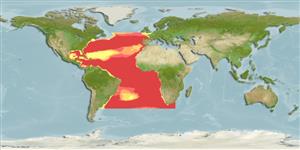Common names from other countries
>
Myctophiformes (Lanternfishes) >
Myctophidae (Lanternfishes) > Diaphinae
Etymology: Diaphus: Greek, dis, dia = through + Greek, physa, phyo = to beget, to have as offspring (Ref. 45335).
More on author: Bleeker.
Environment: milieu / climate zone / depth range / distribution range
экология
морской; мигрирует в океане (Ref. 51243); пределы глубины 0 - 805 m (Ref. 13608), usually 450 - 500 m (Ref. 4775). Subtropical; 51°N - 40°S
Eastern Atlantic: Canary Islands (Ref. 6808), 20°N (inshore from 29°N) to about 10°S west of 0°, with disjunct distribution between 14°N and 8°N, but to 23°S east of 0°. Isolates north to off south-west Ireland (Ref. 4775). Western Atlantic: tropical areas but with expatriate extensions to 51°N and 45°S in western boundary currents [(apparently absent over a minimum region off Brazil) according to Ref. 4479 or 4775] (Ref. 4479, 4775). Very rare or absent in the Indo-Pacific.
Tropical Indian and Atlantic; east coast of South America (Ref. 47377).
Length at first maturity / Size / Вес / Возраст
Maturity: Lm 5.2 range ? - ? cm
Max length : 9.5 cm TL самец/пол неопределен; (Ref. 40727); наибольший возраст (опубликованны данные): 1.00 годы (Ref. 4882)
Краткое описание
определительные ключи | морфология | морфометрия
колючие лучи спинного плавника (общее число) : 0; членистые (мягкие) лучи спинного плавника (общее число) : 14 - 15; колючие лучи анального плавника: 0; членистые (мягкие) лучи анального плавника: 14 - 15.
High-oceanic and mesopelagic populations are found between 225-750 m during the day (maximum abundance at 450-500 m) and is nyctoepipelagic at surface down to 125 m at night (Ref. 4479). Pseudoceanic and pelagic populations are found in the upper 50 m at night (Ref. 4066). Feeding is acyclic in northwest Africa (Ref. 9198).
Life cycle and mating behavior
Maturities | размножение | Spawnings | Egg(s) | Fecundities | личинки
Hulley, P.A., 1990. Myctophidae. p. 398-467. In J.C. Quero, J.C. Hureau, C. Karrer, A. Post and L. Saldanha (eds.) Check-list of the fishes of the eastern tropical Atlantic (CLOFETA). JNICT, Lisbon; SEI; Paris; and UNESCO, Paris. Vol. 1. (Ref. 4479)
Статус Красного Списка МСОП (Ref. 130435)
CITES (Ref. 128078)
Not Evaluated
Угроза для людей
Harmless
Использование человеком
дополнительная информация
инструменты
Специальные отчеты
Скачать в формате XML
ресурсы в Интернет
Estimates based on models
Preferred temperature (Ref.
115969): 6.5 - 13.9, mean 9.6 (based on 46 cells).
Phylogenetic diversity index (Ref.
82804): PD
50 = 0.5000 [Uniqueness, from 0.5 = low to 2.0 = high].
Bayesian length-weight: a=0.00741 (0.00455 - 0.01207), b=3.00 (2.86 - 3.14), in cm Total Length, based on LWR estimates for this species & Genus-body shape (Ref.
93245).
Trophic level (Ref.
69278): 3.0 ±0.00 se; based on food items.
устойчивость к внешним воздействиям (Ref.
120179): высокий, минимальное время удвоения популяции до 15 месяцев (K=1.83-3.81; tm=0.7; tmax=1.2).
Fishing Vulnerability (Ref.
59153): Low vulnerability (10 of 100).
